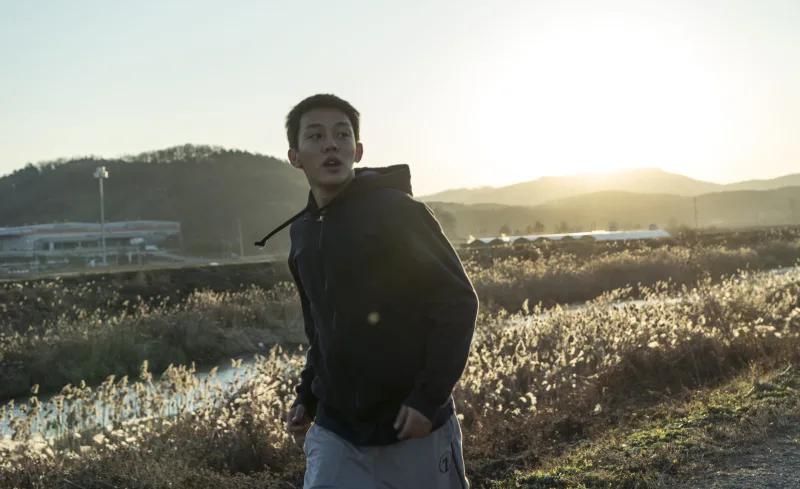
Burning - review: The Great Hunger Dance
Written by: Alexander Gabelia
Probably you all remember the hero of Terrence Stamp from Pier Paolo Pasolini‘s Teorema (1968), who is penetrating into the bourgeois family like a ghost, has intimate connection with each member of the dysfunctional family and becomes the actor of its moral decay. Up to this date, it remains a mystery – whom did the Italian poet mean under the guest? - the devil, the angel, the Christ, the metaphysical ghosts or their unity. Although it is logical that in this class type and allegorical parable the illusory order is violated by the heavenly and authentic substance; Lee Chang-Dong in his work Burning, filmed in 2018, allows the viewer the full freedom of imagination and through mystical and symbolic signs manages to talk about the problems accumulated in the modern world. Here arises a double question: who is Ben (Steven Yeun), after whose appearance the narrative of the film is completely changed and who is the Jong-Su (Yoo Ah-in), who undergoes the metamorphosis after meeting with him and stands naked in front of the spectators at the end of the film.
The inspiration of the director is the story of Haruki Murakami – „Barn Burning.” The text which is not completely cinematographic and is deprived of historical content at the first glance, revives with full perspicuity and captivation in case of/with the Korean magician. Periodically, he is involved in a dialogue with a Fitzgerald and Faulkner. Moreover, in its adapted text, in the independent novel, mystery is created by the constant chain of accumulated questions, emotions and unsuppressed thirst for exploring. This is the style which is characterised to Asian Film-Noir, where even the slightest details are intensifying the black & dark environment, signs of violence, or a variety of psychoanalytic complexes. More globally, each element expresses the late capitalist industry and at the level of persons the libidinal desires and energies are necessarily interpreted as internal impulses. All this is added by Korean local contexts, feeding the film full of mysticism with social subtexts. The emphasis is required on social diversity, dichotomy of urban and rural-peripheral spaces and relationships between alien, lonely and helpless individuals, which is added by the light reaction to internal Asian conflicts.
Everything starts with a lottery draw and a fatal meeting of the young writer-Jong-Su with Hae-mi (Jong-seo Jeon), followed by the convergence of a man and woman and their privacy, which is crowned by the mise en scène of sex. The director refuses to show the passionate and meta-erotic sexual act and nourishes the screen with shyness and uncouthness images.The camera enhances a central character here, and the focus made on the face of the boy showing the alienated and distressed condition of the hero, whose denudation is not spiritual, but is purely of a physical character. His gaze travels from the body of the woman to the room interior and the window view, supplying the scene with psychological layers, which are intensified by traumatic memories of childhood. In its own turn the film background and environment (with Trump's appearance and the voice of imperialistic messages, disordered personal room, synthesis of people and gray space as well as unidentified and scary nature) – are so noticeable and profiteering the social disasters at such an extent, that one has a feeling that it is an independent hero (even more anti-hero).
The situation changes after the woman decides to travel to Africa. The woman entrusts the supervision of her cat to Jong-Su and after some time she returns with an unknown wealthy man (Ben). That is the beginning of the real cat & mouse game and peeping closely into Jong-Su‘s interior world. The director places two separate classes in one area and fills the image with more meanings. If Benn produces the look of a caste which is promoted in today's culture, Jong-Su is an awkward, frustrated and confused person. To illustrate the difference between heroes, it would be thoughtful to compare the aesthetics of their houses. If in one case the camera is moving in an ornamentally carved and luxurious space and generating the image of a consumer society, in the second case the emphasis is made on the brutality of the existence. Among the men stands the woman thus creating a kind of love triangle; the second half of the film resembles deciphering of a multidimensional mathematical task. The narrative is still minimalist, and the action is going on at a slow pace. But the feeling of tension is gradually rising and the director is increasing the emotional observation of the audience hundredfold. Ben's neurotic act, which is expressed through delving into worn-out clothes and searching the store-rooms and drawers, is changed by the passion to trace Ben in the second half of the film.
The turning point of this story is played in the middle of the film. Three heroes exchange their ideas about loneliness, fear of death and ordinary problems in privacy, close to the border of the South and North Korea. However, due to the lack of interrelation, there is a feeling that they are talking to themselves. The scene reaches the highest point of dramatics after smoking marijuana, following to this scene the woman takes off the t-shirt and begins to dance on the background of the sunset. The initial euphoria and admiration reflected on the screen are substituted by sentimental and fascinating emotions. Hae-mi‘s slow and sad dance merges with the dull sunset on the background of Générique‘, perfectly composed by Miles Davis's. Melancholic music increases Hae-mi‘s feelings and melancholy itself, if we refer to Soren Kierkegaard, it becomes her intimate confidant, in which she finds joy and a paradise. The woman's consciousness and the vision of the world goes beyond the traditional moral frames. The improvised nature of jazz is completely and organically merging with the uncontrollable desire to explore.
That very evening Ben will confide Jong-Su‘s his own secret. He burns greenhouses from time to time and receives the pleasure out of this action and at the same time remains unpunished. Quite symptomatic and mysterious remain the fact that after this day Hae-mi disappears without any traces and this fact clearly raises doubts about Ben. The noted episode is accompanied by the chaotic night dream, which shows the contrasts between a adolescent child (presumably herself) and the burnt greenhouses. Deafening silence and unexpected awakening suddenly change the seemingly realistic storyline of the movie into a surrealistic line. The character and the atmosphere of the screen image in the film are as changing as the weather and demonstrate the heroes' emotions and inner moods. Continuous uninterrupted and long-take shots have unique impacts here. If the closely constructed accurate view is introducing the protagonist (Jong-su), the scene of violence begins from the distance and gradually grows into the culmination. The director operates the camera not as a tool for mechanical reproducing, but as a cognitive weapon for the perception of the subject.
The reality and fantasy of the picture are so interconnected and vague that it is impossible to have one-sided attitude after the end of it. If at one point you think the development of the story is determined by the writer and everything (or partly everything) is the part of his fantasy and creativity, at another point you may think that Jong-su is psychologically unbalanced juvenile, which is helped by the psychologist or psychiatrist in the process of rehabilitation (Or it is also his imagination and shows us the forked nature of the human being.) and Hae-mi haunt just the part of his imagination. Otherwise, we may feel the intimacy is established between two men. More precisely, the writer has the inner adherence with the high class representative and his life, and overcoming the difficulties and class revenge takes place at the end of the film, where a man harbors ghosts and inner suffering, becomes physically and spiritually naked, and in turn presents us with a metaphorical visualization of burning greenhouses.
Lee Chang-Dong once again reminds us that the particular thing for a cinematographic medium is not just only to talk about topical issues and superficial illumination of social issues, but the original and complex reflection of these topics. The director provides the opportunity to us to observe the world from the perspective of a protagonist, pass the minefield like him and overcome the frustrations caused by inner fears, hopelessness or love. The story of the main character echoes to and is relevant to the Asian contexts on the one hand, but at the same time it is a universal being equally important for every continent or country. At the end, we can say that although the film ends on the screen, it approaches its climax, but it still develops endlessly in the mind and constantly gives rise to unfamiliar feelings and interpretations.
Written by: Alexander Gabelia















